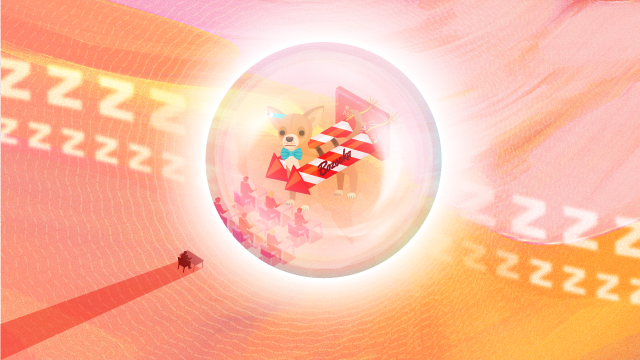5 Theories About the Dreaming Brain

For World Sleep Day, NNR investigates what goes on in the brain during dreams. We uncover fascinating ideas about rapid-eye movement (REM) sleep, the dreams of people born blind, and ask why some dreams are so strange.
1. Dreams don’t just happen during REM sleep
A common misconception is that dreams solely occur during REM sleep. This is a fascinating part of our nightly routine, where brain activity wakes up, whilst the body remains asleep. Happening four or five times per night, REM sleep is where the majority of dreams occur, but innovative studies that prevented REM sleep with drugs, and other studies of people with brain lesions preventing REM sleep showed that dreaming could occur in non-REM sleep. Whilst some evidence suggests that dream reports from non-REM sleep are identical to REM reports, other sources suggest non-REM dreams are less vivid than their REM counterparts.
2. Lucid dreamers' brains aren’t quite asleep or awake
Veiled in mystery, lucid dreaming is a rarely encountered experience of awareness during dream states. Lucid dream occurrence can be increased by training and experienced lucid dreamers can even introduce voluntary decisions into dreams.
But what is happening in the brain during lucid dreaming? Due to their rarity, lucid dreams are hard to study (and much evidence suggests dreams studied in a lab are quite different from dreams we might have at home) but small studies have suggested that EEG signals coming from the lucid brain are different from those of sleep or wakefulness. Brain imaging studies have backed up these findings. Allan Hobson, of Harvard Medical School, hypothesizes that ludic dreaming’s rarity is due to its existence on the cusp of two states – wakefulness and sleep – that our brain intends to be all-or-none.
3. Active brain areas explain why dreams are visual…
Analysis of the dream-heavy REM state brain gives hints as to why dreams often come with such rich imagery. Areas of the visual cortex are heavily activated in REM sleep. A small study by Japanese researchers suggested that the activation is broader in REM sleep than when the awake brain is subjected to visual stimulation.
Are dreams visual for people who experience no visual stimulation whilst awake? Studies of people born blind that involve subjective dream reports suggest that people born blind experience limited visual images during sleep, and instead experience robust references to smell, taste, or touch.
Nevertheless, another study that examined EEG readings in blind and sighted dreamers suggested that correlations of EEG related to visual experience in dreams were similar in both groups and subjects here were able to graphically represent their dreams. Additional analysis suggests that whilst the primary visual cortex is unaffected, a related visual brain area called the extrastriate cortex could be activated in blind subjects through stimulation of other senses, such as touch. These inputs could create virtual images in the brains of congenitally blind subjects, which can then be revealed during dreams.

Inactive brain regions might explain why we don't wake up when we have bizarre dreams.
4. …and passive brain areas explain why dreams are weird
Another common feature of dreams is that the sensory imagery involved is a bit… strange. The analysis of dormant areas in the brain gives a hint. Whilst sensory cortices are lit up, areas of our brain responsible for placing objects in a physical context remain dark, explaining why proportions are often bizarrely distorted in dreams. The right inferior parietal cortex’s inactivity, for example, may explain why we can experience dreams in both first and third person. The dormancy of the executive regions of the prefrontal cortex responsible for reality testing and self-monitoring may be why you remain unfazed as your teacher is replaced by a massive chihuahua armed with a bazooka during a dream about school.
5. Why we dream still remains a mystery – but here are some theories
The function and purpose of dreaming are a hot topic in the field. Below are two leading neurobiological theories behind dreaming. These theories are rather more specific than Freud’s intriguing but refuted theories that dreams are all about wish-fulfilment; you aren’t just having that dream because a bazooka chihuahua is the deepest desire of your heart.
- Dreams help our brain remember: A popular idea is that dreams exist to stabilize our memories of the previous day or represent the brain anticipating the events of the day ahead.
- Dreams let the brain enjoy the silence: REM sleep dreaming is associated with activation of the “default mode” network, which takes over the waking brain when we are idling or not engaged in a particular cognitive task. One theory of dreaming suggests that they arise from the partial activation of this network in the absence of external stimulation. Autobiographical memory areas remain turned off, whilst emotional simulation areas fire up.





